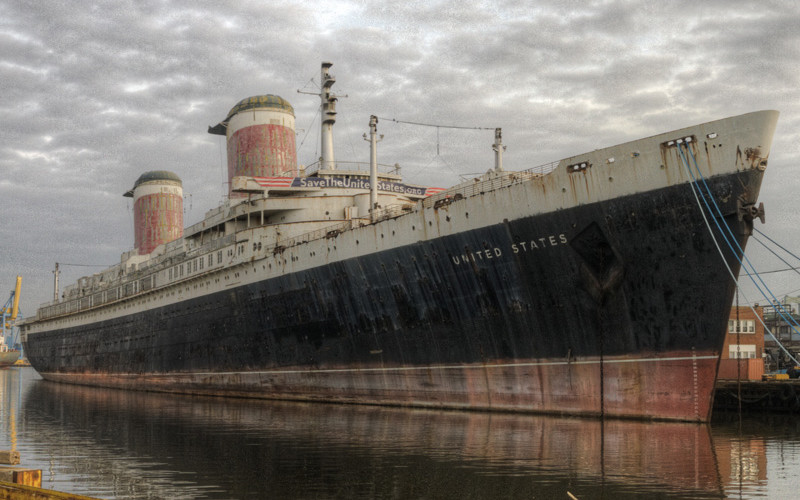The historic ocean liner SS United States must be moved from its Philadelphia pier by Sept. 12 under a federal court ruling.
The nonprofit SS United States Conservancy resisted a move by Pier 82 landlords Penn Warehousing to double dockage fees for the 1950s luxury liner, which the conservancy has hoped to convert to a mixed-use development and maritime museum since acquiring the ship in 2011.
But U.S. District Court Senior Judge Anita Brody, while ruling against the rent increase attempt, also directed the conservancy to move the 992’ ship from where it’s been tied up since 1996.
“While the Conservancy was vindicated in not being compelled to pay a large sum of back rent to the SS United States’ pier operator, the ruling makes clear this iconic American symbol is in peril,” said SS United States Conservancy president Susan Gibbs, the granddaughter of the ship’s designer, William Francis Gibbs.
“The judge’s decision gives us a very limited window to find a new home for the SS United States and raise the resources necessary to move the ship and keep her safe. We must do both to avoid the tragic fate that countless supporters from around the world have worked for over a decade to prevent,” said Gibbs.
Even amid the ongoing rent dispute, the conservancy in November 2023 announced a new redevelopment plan produced by RXR and MCR Hotels.
“The ship’s redevelopment would create thousands of jobs and generate millions of dollars in annual tax revenue,” according to the conservancy. “The redevelopment plan can be adapted to any suitable home port city, but it cannot advance until a permanent home for the ship is secured.”
Once the epitome of American maritime engineering prowess, the 992’x101’ liner was the world’s fastest passenger ship when it entered service in 1952, clocking a trans-Atlantic crossing at a sustained 35 knots, powered by Babcock & Wilcox boilers and Westinghouse geared steam turbines. The liner was subsidized by the U.S. government, and capable of rapid conversion to a troopship.
With World War II and the battle of the Atlantic a fresh memory for U.S. defense planners, it was thought the SS United States could sealift reinforcements to a new confrontation in Europe while outrunning the danger of Soviet submarines.Capable of crossing the Atlantic in three and a half days, the ship was a popular ride with celebrities of the day.
But in time the SS United States like other trans-Atlantic liners faced competition from the growing airline industry, and it went out of service in 1969.
The ship passed through several owners before winding up in Philadelphia in 1996, and proposals for reuse followed over the years. The conservancy has envisioned the ship restored for an educational mission, combined with creative commercial use such as hotel or tech businesses.
On the day of the ruling the organization launched another urgent campaign to seek new support.
“When the SS United States has faced imminent danger before, supporters from across the country and around the world have always stepped up to save her from destruction.
Relocating a ship the size of the SS United States is complex and costly. It requires funds for insurance, tugs, surveys, and dock preparations to ensure the ship’s safe passage to a new home,” Gibbs said.
The conservancy says it “has been actively exploring potential pier locations in the Philadelphia area and along the East Coast able to accommodate the nearly 1000-foot-long ocean liner. The Conservancy has also been engaging in targeted outreach to federal and state officials who could help with that effort. “
Along with its long effort to find a permanent home for the ship, the conservancy also has a mission to educate the public about the ship’s historical importance and advancing its curatorial mission through exhibitions, events, and the care of a major museum collection of original furniture, artwork, ephemera, archival documentation, and historic components from the ship.
“As we approach our nation’s 250th birthday, the loss of this American masterpiece could be viewed at home and abroad as a tragic metaphor. A unique historic achievement that bears the name of our great nation should not be at grave risk of destruction. While the Conservancy is responsibly preparing for all possible scenarios, we have great faith that our global community of supporters will help us meet this latest challenge. We must all come together to save this symbol of American pride anand innovation,” Gibbs added.





